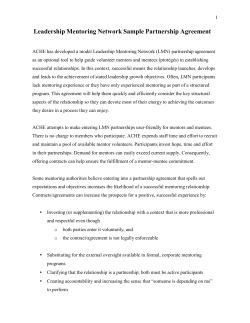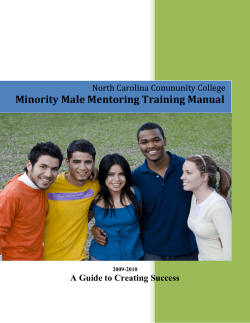
Mentor: Everyone Needs One!
WLG 301 Mentor: Everyone Needs One! Susan Gamble, M.P.A., M.S.W., WVU Extension Agent, Literacy Zona Hutson, M.A., WVU Extension Agent, Doddridge County Patrick Nestor, Ed.D., WVU Extension Specialist, Volunteer Development Educational Objectives 1. Participants will gain an understanding of the mentoring process. 2. Participants will discover the characteristics of a good mentor. 3. Participants will be motivated to become mentors. 4. Participants will learn the basic steps to start a mentoring program. The word “mentor” comes from ancient Greece. Mentor was the name of the loyal friend of Odysseus. When Odysseus left to fight in the Trojan War, he entrusted his son, Telemachus, to Mentor. Since that time, mentor has meant a wise, trusted, loyal adviser, leader, or coach. Today, mentor means any caring person who develops an ongoing, one-to-one relationship with someone else. A mentor listens, encourages, gives advice, advocates, serves as a role model, and shares information and experiences with a mentee. This topic will guide you in developing, encouraging, and directing members of your organization to serve as mentors. What Is Mentoring? Mentoring is the process by which an experienced person provides advice, support, and encouragement to a less experienced person. A mentor serves as a role model, friend, or coach, leading by guidance and example. Mentoring is becoming an increasingly popular strategy for addressing the needs of both youths and adults. In a mentoring relationship, the focus is on a specific area of growth in a flexible format. An effective mentoring program can change lives by providing opportunities for personal development, growth, and support for both the mentor and mentee. Mentoring happens in both one-to-one settings and groups. The process may involve general conversations, personal meetings, e-mail exchanges, or letters. – continued – WVU Extension Service Families and Health Programs Activity Help participants discover strengths and traits they could share with others. 1. What am I passionate about? 2. How do I spend my time? 3. What topics do I enjoy learning about? 4. How would I describe my gifts, strengths, and talents? 5. In what areas do I wish to grow? Role of a Mentor A mentor can assume different roles. The mentor’s role depends on the needs of the mentee. To successfully fill theses roles, a mentor should establish a positive, personal relationship with the mentee based on mutual trust and respect. A mentor should: ● maintain regular interaction ● provide consistent support ● help mentee develop life skills ● help mentee become aware of community, educational, and economic resources ● realize that each mentoring experience is unique ● act as a guide, advocate, coach, and role model ● have fun! Characteristics of a Mentor A successful mentor is characterized as: Supportive: A mentor supports the needs and aspirations of the mentee. The mentor encourages the mentee to accept challenges and overcome difficulties. Patient: A mentor is patient and willing to spend time performing mentoring responsibilities. Respected: A mentor has earned the respect of peers within the organization and the community. People-oriented: A mentor is genuinely interested in people and has a desire to help others. Good motivator: A mentor provides encouraging feedback and challenging assignments. Open-minded: A mentor is concerned for and accepting of others. Tips for Building a Mentoring Relationship 1. Be there. Make time for your mentoring relationship, showing your mentee that you care and that the relationship is a priority. 2. Be a friend, not an all-knowing authority. You do not need to “fix” your mentee. 3. Be an individual of character. Keep your word and have a positive outlook. 4. Choose a wide range of activities that are of interest to both of you. Activity Have participants think about people who have served as their mentors: Name a mentor from your childhood. Name a mentor from your high school or college experience. Name a mentor from your job or career. Name a person who is currently mentoring you. What characteristic do these people possess? How did these mentors contribute to your success or achievement? WVU Extension Service Families and Health Programs Starting a Mentoring Program A mentoring relationship is a close, individualized relationship that develops over time. Successful mentoring is rewarding for both the mentor and mentee. Mentoring strengthens an individual’s skills and confidence to face the future. Here are some suggestions for starting a mentoring program. Examples of Mentoring Activities Set your mentoring goals together. ● Attend plays at the local community center. ● Visit local libraries. ● Help a student with homework. ● Go to the movies together. ● Talk about your first job. ● Talk about balancing work and life. ● Talk about making connections. ● Cook a meal together. ● Share your culture and background. ● Do some volunteer work together. ● Activity Establish program need: Identify the needs of the organization/community. ● Establish a balance: Mentoring programs must complement, not compete with, other activities and responsibilities. ● Develop program goals and objectives: Decide what you want to accomplish and how you will do it. ● Identify the needs of the mentee: Participation is voluntary. So be sure to understand why the mentee is participating. ● Organize activities and procedures: Establish guidelines for the length and frequency of the mentor contact. ● Monitor the process: Stay in touch to ensure the success of the program. ● Evaluate ongoing progress: Is it a win-win situation for both mentor and mentee? Is the organization benefiting from the relationship? ● Revise the program and action steps: Make changes as needed based on information received from the mentors, mentees, and others. ● Have participants brainstorm potential mentoring opportunities: What are the mentoring needs of the organization or community? How can you address those needs through a mentoring program? WVU Extension Service Families and Health Programs National Mentoring Month January is National Mentoring Month. Its promoters aim to raise awareness about mentoring, to recruit individuals to mentor, and to promote the rapid growth of mentoring by partnering with organizations, companies, faith communities, schools, and community groups. To learn more, visit the Web site (www.mentoring.org). References California Governor’s Mentoring Partnership (2001). Primary role of a mentor. (www.mentoring.ca/gov/ mentor_roles.shtm). California Governor’s Mentoring Partnership (2001). Tips for building a mentoring relationship. (www.mentoring.ca.gov/mentor_relationship.shtm). Crochelt, L. and Smink, J. (1991). The Mentoring Guide Book, Clemson University, Clemson, S.C. PP. 1-107. DuBois, D; Holloway, B and Valentine, J. (April, 2002). Effectiveness of Mentoring Program for Youth: A MetaAnalytic Review, American Journal of Community Psychology, vol. 30, No. 2. Management Mentors (n.d.). Formal vs. Informal Mentoring. (www.management-mentors.com/why_mentoring/formal_ vs_informal.shtml). Mentor (n.d.) Becoming a mentor. Retrieved November 27, 2006 from www.mentoring.org/mentors/index.php. Nestor, P., Mentoring: Treasures of the Trail, (1999), West Virginia University Extension Service, Morgantown, WV. U.S. Department of Labor. (2000.) Retrieved June 9, 2006 from www.dol.gov/odep/pubs/ek00/mentoring.htm. 2006:1M Programs and activities offered by the West Virginia University Extension Service are available to all persons without regard to race, color, sex, disability, religion, age, veteran status, political beliefs, sexual orientation, national origin, and marital or family status. Issued in furtherance of Cooperative Extension work, Acts of May 8 and June 30, 1914, in cooperation with the U.S. Department of Agriculture. Director, Cooperative Extension Service, West Virginia University. ES06–200 WVU Extension Service Families and Health Programs
© Copyright 2025





















